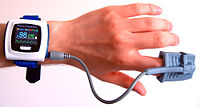
Photo from wikipedia
The Safeguarding the Brains of our smallest Children (SafeBoosC) project was initially established to test the patient-relevant benefits and harms of cerebral oximetry in extremely preterm infants in the setting… Click to show full abstract
The Safeguarding the Brains of our smallest Children (SafeBoosC) project was initially established to test the patient-relevant benefits and harms of cerebral oximetry in extremely preterm infants in the setting of a randomized clinical trial. Extremely preterm infants constitute a small group of patients with a high risk of death or survival with brain injury and subsequent neurodevelopmental disability. Several cerebral oximeters are approved for clinical use, but the use of additional equipment may disturb and thereby possibly harm these vulnerable, immature patients. Thus, the mission statement of the consortium is “do not disturb—unless necessary.” There may also be more tangible risks such as skin breakdown, displacement of tubes and catheters due to more complicated nursing care, and mismanagement of cerebral oxygenation as a physiological variable. Other monitoring modalities have relevance for reducing the risk of hypoxic-ischemic brain injury occurring during acute illness and have found their place in routine clinical care without evidence from randomized clinical trials. In this manuscript, we discuss cerebral oximetry, pulse oximetry, non-invasive electric cardiometry, and invasive monitoring of blood pressure. We discuss the reliability of the measurements, the pathophysiological rationale behind the clinical use, the evidence of benefit and harms, and the costs. By examining similarities and differences, we aim to provide our perspective on the use or non-use of cerebral oximetry in newborn infants during intensive care.
Journal Title: Frontiers in Pediatrics
Year Published: 2022
Link to full text (if available)
Share on Social Media: Sign Up to like & get
recommendations!